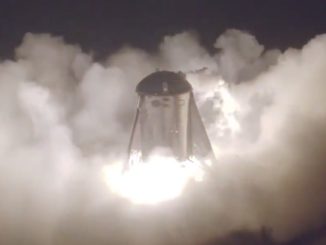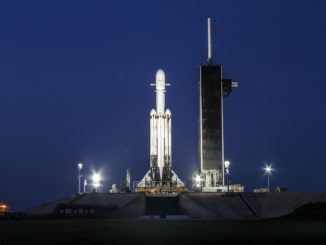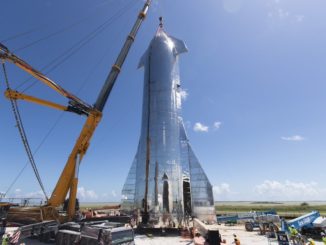
SpaceX will need another six weeks or so to finish implementing hundreds of changes to its Super Heavy-Starship rocket and the gargantuan booster’s Texas launch pad before it will be ready for a second attempt to reach orbit, company founder Elon Musk said Saturday.
That’s assuming Federal Aviation Administration clearance to fly in the wake of the Super Heavy’s dramatic maiden launch April 20 in which the rocket blew itself up after multiple engine failures and the Starship upper stage’s failure to separate from the first stage booster.
In a Twitter Spaces discussion with author Ashlee Vance, Musk said SpaceX is implementing “well over a thousand” changes,” and “I think the probability of this next flight working, getting to orbit, is much higher than the last one. Maybe it’s like 60 percent. It depends on how well we do at stage separation.”
The reusable Super Heavy first stage is equipped with 33 methane-powered Raptor engines while the Starship second stage features six. The original design called for the Super Heavy’s engines to shut down after boosting the Starship out of the lower atmosphere. The Starship then would separate and ignite its own engines to continue on to orbit.
During the rocket’s maiden flight, a half-dozen engines shut down or never started and the Starship never separated from the Super Heavy first stage.

After reaching an altitude of just 24 miles or so, the entire vehicle began tumbling, falling about six miles before its self-destruct system activated, blowing the rocket apart. The self-destruct system took longer to respond than expected.
For its second flight, Musk said the stage separation system has been modified, a “late breaking change that’s really quite significant.”
The Starship’s engines will begin firing before all of the Super Heavy engines have shut down. This so-called “hot staging” technique has been used for years in Russian rockets. Musk said it would improve the performance of the Super Heavy-Starship by reducing the velocity lost between first stage engine shutdown and ignition of the upper stage engines.
“We shut down most of the engines on the booster, leaving just a few running and then at the same time, start the engines on the ship, or upper stage,” he said. “Obviously that results in kind of blasting the booster, so you’ve got to protect the top of the boost stage from getting incinerated by the upper stage engines.”
The solution is to add shielding to the top of the Super Heavy stage, along with an extension featuring vents to direct the upper stage engine exhaust plumes away from the lower stage during their initial startup.
“There’s a meaningful payload-to-orbit advantage with hot staging, that is conservatively about a 10 percent improvement if you basically just never stop thrusting,” Musk said. “In order to do this, you actually have to have vents, the super hot plasma from the upper stage engines has got to go somewhere.
“So we’re adding an extension to booster that is almost all vents, essentially. So that allows the upper engine plume to go through the vented extension of the booster and not just blow itself up. So this is the most risky thing, I think, for the next flight.”
Addressing engine problems seen during the rocket’s first flight, Musk said engineers are implementing changes to the Raptor’s hot gas manifold that directs super-heated methane-rich gas toward the combustion chamber. The high temperatures can create leak paths through bolt holes where the manifold is attached.
The manifold itself has been redesigned, Musk said, and higher torque settings will be used to tighten bolts more securely and eliminate potential bolt-hole leak paths.

Another major issue being addressed: damage to the Super Heavy-Starship launch pad at SpaceX’s Boca Chica, Texas, flight test facility.
During the Super Heavy’s maiden flight, the exhaust from the first stage Raptor engines severely eroded the pad’s concrete footings. Musk said the company is in the process of adding roughly 1,000 cubic meters of steel-reinforced high-strength concrete.
“On top of that, we have a sort of a steel sandwich, which is basically two thick plates of steel that are welded together with channels going through (with) perforations in the top so it will actually shoot a lot of water out,” he said.
“Think of it like a gigantic upside-down shower head. It’s going to basically blast water upwards while the rocket is over the pad to counteract the massive amount of heat from the booster. The booster is basically like the world’s biggest cutting torch with a massive amount of … heat, but also a massive amount of force.”
He said the modifications amount to “overkill” that should leave “the base of the pad in much better shape than last time.” In addition, the rocket will take off at a higher throttle setting to get the vehicle away from the pad faster.
One question that was not addressed in Saturday’s discussion was the Super Heavy-Starship’s self-destruct system, which took much longer than expected to activate after the rocket tumbled out of control in April.
The FAA will have to sign off on that system and any other safety-related upgrades before a launch license will be granted.
Asked how much SpaceX has invested in the Super Heavy-Starship program to date, Musk said he did not know the exact amount, “but it’s over $2 billion” and could approach $3 billion by the end of this year.
Asked what he considers the biggest challenge facing the Super Heavy-Starship in terms of producing a commercially viable rocket, Musk said he does not yet know “because we have not yet reached orbit.”
“If we knew what it was, we would actually fix it before launching,” he said. “So in launching, what you’re doing is trying to resolve the unknowns which you cannot know before you launch, or at least we are not smart enough to know. So like I said, what appears to be the biggest risk right now is stage separation.”



